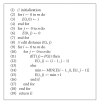Improved candidate drug mining for Alzheimer's disease
- PMID: 24719894
- PMCID: PMC3955684
- DOI: 10.1155/2014/897653
Improved candidate drug mining for Alzheimer's disease
Abstract
Alzheimer's disease (AD) is the main cause of dementia for older people. Although several antidementia drugs such as donepezil, rivastigmine, galantamine, and memantine have been developed, the effectiveness of AD drug therapy is still far from satisfactory. Recently, the single nucleotide polymorphisms (SNPs) have been chosen as one of the personalized medicine markers. Many pharmacogenomics databases have been developed to provide comprehensive information by associating SNPs with drug responses, disease incidence, and genes that are critical in choosing personalized therapy. However, we found that some information from different sets of pharmacogenomics databases is not sufficient and this may limit the potential functions for pharmacogenomics. To address this problem, we used approximate string matching method and data mining approach to improve the searching of pharmacogenomics database. After computation, we can successfully identify more genes linked to AD and AD-related drugs than previous online searching. These improvements may help to improve the pharmacogenomics of AD for personalized medicine.
Figures





Similar articles
-
Molecular pathology and pharmacogenomics in Alzheimer's disease: polygenic-related effects of multifactorial treatments on cognition, anxiety and depression.Methods Find Exp Clin Pharmacol. 2007 Jul;29 Suppl A:1-91. Methods Find Exp Clin Pharmacol. 2007. PMID: 17957277 Review.
-
Pharmacodynamic, pharmacokinetic and pharmacogenetic aspects of drugs used in the treatment of Alzheimer's disease.Clin Pharmacokinet. 2013 Apr;52(4):225-41. doi: 10.1007/s40262-013-0038-9. Clin Pharmacokinet. 2013. PMID: 23408070 Review.
-
Comparison of cholinesterase inhibitor utilization patterns and associated health care costs in Alzheimer's disease.J Manag Care Pharm. 2008 Jun;14(5):451-61. doi: 10.18553/jmcp.2008.14.5.451. J Manag Care Pharm. 2008. PMID: 18597574 Free PMC article.
-
[Retrospective comparative analysis of antidementia medication persistence patterns in Spanish Alzheimer's disease patients treated with donepezil, rivastigmine, galantamine and memantine].Rev Neurol. 2006 Oct 16-31;43(8):449-53. Rev Neurol. 2006. PMID: 17033976 Spanish.
-
Pharmacogenomics in Alzheimer's disease.Methods Mol Biol. 2008;448:213-357. doi: 10.1007/978-1-59745-205-2_10. Methods Mol Biol. 2008. PMID: 18370236 Review.
Cited by
-
Exploring the Role of Guanylate-Binding Protein-2 in Activated Microglia-Mediated Neuroinflammation and Neuronal Damage.Biomedicines. 2024 May 20;12(5):1130. doi: 10.3390/biomedicines12051130. Biomedicines. 2024. PMID: 38791092 Free PMC article.
References
-
- Berchtold NC, Cotman CW. Evolution in the conceptualization of dementia and Alzheimer’s disease: Greco-Roman period to the 1960s. Neurobiology of Aging. 1998;19(3):173–189. - PubMed
-
- Thies W, Bleiler L. 2013 Alzheimer’s disease facts and figures. Alzheimer’s & Dementia. 2013;9(2):208–245. - PubMed
-
- Kruglyak L, Nickerson DA. Variation is the spice of life. Nature Genetics. 2001;27(3):234–236. - PubMed
-
- Voisey J, Morris CP. SNP technologies for drug discovery: a current review. Current Drug Discovery Technologies. 2008;5(3):230–235. - PubMed
Publication types
MeSH terms
LinkOut - more resources
Full Text Sources
Other Literature Sources
Medical

